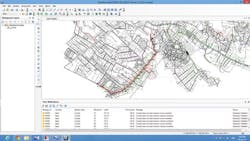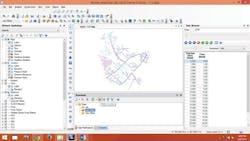Q&A with Bentley's Robert Mankowski
With 20 years of experience and seven patents under his belt, Robert Mankowski knows hydraulic modeling. He currently leads the product teams responsible for Bentley’s MicroStation, civil engineering, water resources, geospatial, and geotechnical product lines. In the following Q&A, Mankowski discusses different types of data and how they can provide unprecedented insight into water and wastewater utility operations.
Q: What exactly is hydraulic modeling?
Robert Mankowski: Hydraulic modeling is the process of creating a mathematical representation of a real system using a 3D model that simulates the hydraulic behavior of the system. These models are created using applications, such as Bentley’s WaterGEMS or SewerGEMS [software], specifically designed for this purpose.
There are several other modeling types used by utilities other than hydraulic modeling. They include water quality modeling, energy use modeling, reliability and performance modeling, operational analytics, and various types of optimization.
Q: What is the best way to use CAD software in the water/wastewater sectors?
RM: How utilities model water and wastewater systems continues to evolve. Where once utilities modeled their systems strictly for traditional design and planning purposes, these models can now provide decision-support capabilities to utilities that improve operational efficiency particularly in the context of asset management and asset performance management.
They can also use the model to determine the capital improvements necessary to meet the current and future needs of the populations they serve, or understand how to respond to emergencies like pipe breaks or other large unplanned water usage, such as firefighting, while minimizing the impacts to the overall system, or how to flush the system in response to an unexpected water quality event like a chemical spill.
By creating a 3D model, engineers are able to gain a better understanding of the real system, which leads to better decisions and better performing assets.
Q: Many different software types exist - modeling, GIS, SCADA, smart metering data, etc. Do you think there are water utilities unfamiliar with the capabilities of these systems?
RM: There are many water and wastewater utilities across the world, some of which are very small, local operators. So yes, I think there are some utilities out there that only have a notional idea of the capabilities of these types of solutions, or don’t believe they would add a lot of value in the context of their system. With that said, I think most utilities of reasonable size and sophistication have a good understanding of the capabilities, but I don’t think many have really maximized the use of these systems in an integrated asset management process. While some utilities have implemented one or more of these systems, and each has value as a stand-alone system serving a specific purpose within a utility, we believe there is greater value to be achieved by integrating these systems with a common information management environment.
Q: What is a common information management environment and how can it benefit a water utility?
RM: When implemented, a common information management environment allows owner-operators to apply the commonality of business processes and information models across the full lifecycle of their assets, magnifying the benefits of each individual information system they’ve deployed.
Q: What role do sensors play?
RM: The proliferation in the use of sensors is leading to increased monitoring and measurement of water and wastewater network and plant assets. The convergence of information, operational, and engineering technologies and their data will assist water and wastewater owners to move from a reactive to proactive predictive mode in maintenance management. This will lead to better-informed emergency response to main bursts, or dealing with combined sewer overflows for example. This will improve their operational efficiencies such as energy and carbon management. But, more importantly, it will deliver a better level of service to customers.
Q: What is the difference between the data water utilities get from models as opposed to the data they get from other software, such as SCADA?
RM: Well, for one thing, models provide data by simulating the existing system or a proposed system, whereas SCADA provides a remote view of real-time or near real-time measurements at specific points of the actual system. SCADA usually involves an historian to review past performance at these points. But a SCADA system can’t predict the future other than by simple extrapolation, and it can’t fill in between sensors without some gross simplification. That’s why SCADA and modeling technologies are very complementary.
Moreover, models can provide simulated measurements at virtually every point in the system. They fill in the gaps of information where there are no sensors in the SCADA system. Models are also used to predict the behavior of the system, which, of course, is impossible to measure. Models can predict how the system will behave if certain capital or operational decisions are taken without actually making those changes to the real system. For example, an operator can predict how tank levels and pressures in the system will change as the result of turning a pump on or off without making any changes to the real water system by using a model. This provides the operator with valuable insight that can support decision making.
Q: Can SCADA data be integrated into a model?
RM: Yes, absolutely. The real-time data from SCADA systems can provide models with their initial starting values for the simulation, such as tank levels and pump and valve settings. We refer to these settings as boundary conditions. Additionally, historic SCADA data can be used to calibrate and validate the model. In other words, it helps ensure that the modeled behavior actually reflects the performance of the real-world system with some degree of accuracy. This is a very important step in the modeling process.
Conversely, models can also be integrated into SCADA systems to improve operational decision making, as I described before. In addition, the results of modeled simulations can be seamlessly integrated into the SCADA software’s human machine interface, so operators can benefit from modeling without having to learn an entirely new application and its user interface. This also provides a useful training environment for control room operators and the opportunity to carry out forensic analysis of past events to better understand why it happened and how to respond better in the future.
Q: What about GIS data? Can that be integrated as well?
RM: GIS has been integrated with models for almost two decades. At first, GIS was primarily used as the source of information for the geometric and physical characteristics of the system. In other words, the pipe locations and physical properties such as material, diameter, and year of installation were managed by the GIS and imported into the hydraulic modeling software to create the basic model. This was a big turning point in the level of detail of modeling when we went from working with schematics of a highly simplified system to “all pipe” models.
Now GIS integration is much deeper and richer than that. Modelers can work directly in GIS software products and have bi-directional synchronization between the models and GIS. One of the main benefits of this is that it can extend the reach of the modeling information to executives, managers, and customer service personnel who would never directly use a hydraulic model but have access to the GIS.
Q: Is it the same with smart metering data?
RM: Smart metering data can be integrated into models in a similar fashion to SCADA data. The historical data gathered by smart meters can be used to estimate average and peak demands and diurnal patterns needed for the model, and the real-time demand data can be used to set the initial conditions for simulations and for demand forecasting.
This nicely illustrates why we believe a common information management environment can be so valuable. It’s the integration of all these systems applied to business processes that help utilities achieve better outcomes like reduced costs, improved service, and less risk.
Q: What kind of data are utilities looking for today, and what capabilities do you think they are looking for?
RM: Bentley works with utilities all over the world, and I would say that the answer varies, but there are some general patterns. One pattern is starting with modeling as a point solution in master planning and design, and evolving to using modeling as an integral part of an overall asset management process for intelligent infrastructure.
Q: What about in the developing word? Are the objectives different?
RM: In the developing world, we see a lot of emphasis on planning and design to improve the level of service within the utility’s coverage area. We have some great examples from India of utilities that have transformed intermittent water supply systems into reliable 24/7 sources of clean drinking water. We also have some great examples of the expansion of wastewater collection systems, and the social and economic benefits of this.
Q: Can modeling help reduce non-revenue water?
RM: Utilities across the world are focused on reducing non-revenue water. This generally has two components - real losses (i.e., leaks) and apparent losses (theft or meter issues) - and modeling can be very useful in dealing with either. This is very important to utilities because it has a big impact on the costs of treating and pumping, and also on the preservation of a scarce resource, which can be a hot political issue in drought-stricken areas.
Q: Can modeling help with energy management?
RM: The cost of energy for pumping can often be one of the largest operating expenses for a water utility. We have seen utilities do extensive modeling of their energy costs and integrate these models into real-time systems to improve operational decisions.
To summarize, I think utilities will continue to look for capabilities that can help them minimize the lifecycle costs of owning and operating their infrastructure while continuing to improve the levels of service they provide with low levels of risk. This is the definition of asset management, and, ultimately, that’s what it is all about.
Robert Mankowski is vice president of simulation product management for Bentley Systems. He joined Bentley Systems in 2004 when Bentley acquired Haestad Methods, a pioneer in object-oriented hydraulic analysis software, where he served as chief technical officer. Mankowski has 20 years’ experience in software development and is a co-inventor of seven patented technologies. He earned a BS in civil engineering from Drexel University and is a licensed professional engineer in California.




